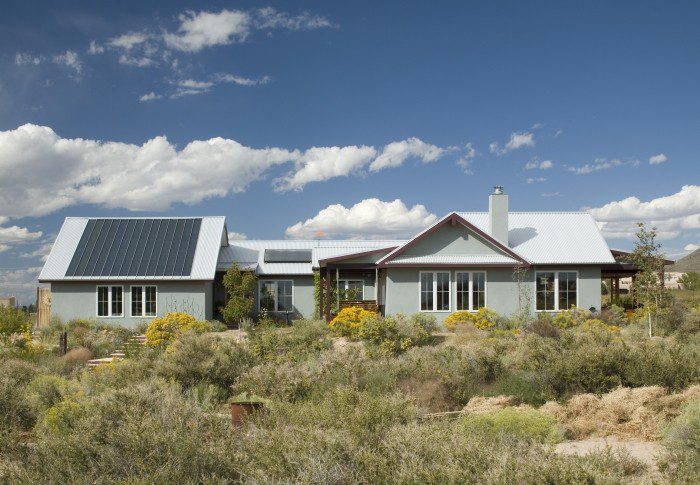
Building smaller has many advantages, both practical and philosophical. A smaller home costs less to build and operate and is easier to maintain. It is important to recognize some of the diminishing returns when it comes to the size of a home. We have all visited or lived in houses with spaces that are rarely used. These spaces still need to be maintained, heated and cooled and can actually detract from the comfort and livability of a home. Designing a house that is optimized for how you live just makes sense. Just how small and optimized depends on the specifics of the project, but it’s a good exercise to examine how much space you really need and optimize the design accordingly.
Values + Goals for Green Home Living
Designing, building, and living in a well-designed, not-so-big, custom home starts with a unique set of values, goals, and perspectives. It is a departure from the contemporary American status quo where bigger is better and more is best. It's important to realize that a small, energy efficient, well-designed home can be just as comfortable, beautiful, inviting, functional, and interesting as a big home, often even more so. When space is carefully considered and valued, making every square foot count is important. Deciding upon the size of your new home and how the square footage is allotted will depend on your individual needs, wants, and lifestyle. When energy efficiency, low environmental impact, and living green is valued, it's surprising how much good living you can comfortably fit in a small home plan.
Small, Green Home Design Strategies
What follows are some design strategies that make our small, energy efficient home plans comfortable and functional while feeling open and cozy:
Natural Day Lighting
Rooms with ample natural light feel more spacious and inviting and are more energy efficient, too. We design our homes to have natural daylight on least two and often three sides of every room. Orienting the home with the path of the sun makes this task easier, but we use other strategies too, for example, interior windows that transfer light into north-facing rooms and skylights or clerestories that admit natural daylight where it might not otherwise be possible.
Vaulted or Higher Ceilings
People perceive space as a volume rather than simply the floor area. A room with natural daylight and vaulted ceilings can be small in terms of the area, but the volume makes it feel roomy, cheerful, and welcoming. Interesting ceiling details can draw the eye up and help exaggerate this sense of volume. Too much volume can be a problem, so it’s important to size these spaces correctly and in proportion to the human scale. With our SIP panelized construction, the pitch of the roof outside becomes the ceiling pitch inside and naturally creates interesting interior volumes. Some spaces such as closets and bathrooms do not need high ceilings so it’s possible to fur down the ceilings in these spaces and utilize the volume above for sleeping lofts or storage areas. Lofts can also create dropped ceilings in rooms to add extra usable space while also breaking up the ceiling height and adding visual and spacial interest.
Dual Purpose Space
In the design process we collaborate closely with our clients to find ways to use spaces for multiple purposes. A hallway can also be the "library" with built-in bookshelves, which also add interest and can buffer sound. Or there can be a built-in, fold-out shelf for gift wrapping, craft projects, or an electric piano! An office or exercise room with a loft or a Murphy bed can transform into a guest room when needed. A workshop can expand into the garage for larger projects. Combine a study with an exercise room, a sewing room with the laundry, or a workshop with a mud room and increase the usability of the rooms. This affords you more comfortable living in less space.
Logical Flow
Circulation spaces in a home can account for a large percentage of a home’s square footage. Some amount of circulation space is required in a house but too much is a waste. It is important to lay out a house in such a way as to create clear transitions from public to private spaces but it’s also important to do so in the most efficient way possible. For example, rather than wall off an office or study completely, it is possible to make it a room that you walk through to get to another room. This allows you to add the floor area and windows that would be otherwise used for a useless hallway to the room, making it a more pleasant and efficient use of space. Logical flow from inside to outside is also very important. When your indoor spaces connect conveniently to comfortable outdoor spaces, you can significantly expand your living area. Our homes are designed to flow effortlessly from indoors to outdoor porches, patios, and decks. When oriented with the sun and prevailing winds, these outdoor spaces can be little jewels where people naturally gravitate and want to spend time. Covered porches, with screens in some areas, can become sleeping porches or a second living or dining room.
Well-Utilized Space
Typically, bedrooms are used only at night. Why give extra space to a room in which you are usually asleep? We suggest trimming the bedrooms and putting that space in rooms that are used during the day. Some of our clients are really brave and reduce the size of their closets as well. Do we really need all those clothes at any given time? A smaller wardrobe that is recycled more frequently saves space and can work great.
Open Rooms
The great room concept is great for several reasons. When rooms are open to one another, the volume of all the rooms combines and feels more spacious. In larger homes, big rooms with vaulted ceilings can easily feel cavernous and unfriendly. Not so with small homes. Their proportions are more in line with the human scale. Fewer walls mean fewer halls and since walls and halls take up floor space, reducing them means more usable square footage.
Color
Spaces with light colors feel larger and more open. Darker colors can work in open, south facing rooms or as accents. Much has been written about the use of color in homes. Color is a powerful tool that adds interest and can set the mood.
Smaller Furniture
Go furniture shopping with a tape measure; the size ranges are interesting! Typically, Scandinavian furniture is smaller than American furniture and comfort is not sacrificed. Unless your current furniture has sentimental value, consider new, smaller pieces. The difference in size could change your space needs significantly.
Considerations
Choosing to downsize is a big decision and should be carefully considered (and agreed upon) ahead of time. Often it means developing a new mindset. There are always trade-offs. A smaller home may mean less time and cost to clean and maintain, less environmental impact and a smaller mortgage, but it also may mean less storage space, and giving up your study when guests come to visit (or having them stay in a motel). Our past clients who have downsized enthusiastically rave about their new, more simple lifestyle. This is a personal decision, however, and is worth careful consideration.
